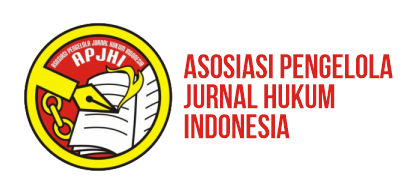Perlindungan Pengetahuan Tradisional sebagai Hak Konstitusional di Indonesia
DOI:
https://doi.org/10.31078/jk1718Keywords:
Culture, Traditional Knowledge, Constitutional RightsAbstract
Indonesia is a country that has abundant genetic resources, multi ethnicity, and diverse cultures. This situation makes Indonesia very rich in traditional knowledge. Protecting traditional knowledge is very important because traditional knowledge is the identity of the community as the owner. Through Article 18B Paragraph (2) and Article 28I Paragraph (3) of the 1945 Constitution, traditional knowledge which is a traditional right and the identity of the indigenous culture are implicitly recognized as constitutional rights. Protection of traditional knowledge in Indonesia is regulated in the Copyright Law, Patent Law, and Culture Promotion Act. However, the protection of traditional knowledge in Indonesia has not been optimal, because it has not provided adequate protection to traditional knowledge.
References
Daulay, Zainul., 2011, Pengetahuan Tradisional : Konsep, Dasar Hukum, Dan
Praktiknya, PT. Raja Grafindo Persada, Jakarta.
Jurnal
Antons, Christoph., 1(1) 2009, “What is “Traditional Cultural Expression?”,
International Definitions And Their Application in Developing Asia”, W.I.P.O.J.
2009, 1(1), 103-116, WIPO Journal, pp. 103-116.
Asmah, Josephine., 2008, “Historical Threads: Intellectual Property Protection
Of Traditional Textile Designs: The Ghanaian Experience And African
Perspectives”, I.J.C.P. 2008, 15(3), 271-296, International Journal of Cultural
Property, pp. 271-296.
Blakeney, Michael., 2000, “The Protection Of Traditional Knowledge Under
Intellectual Property Law”, E.I.P.R. 2000, 22(6), 251-261, European Intellectual
Property Review, pp. 251-261.
Chieh, Yang Chih., 2010, “A Comparative Study Of The Models Employed To Protect
Indigenous Traditional Cultural Expressions”, 11 Asian-Pac. L. & Pol’y J. 49,
Asian-Pacific Law and Policy Journal, pp. 49-84.
Conway, Danielle M., Summer 2011, “Promoting Indigenous Innovation, Enterprise,
And Entrepreneurship Through The Licensing Of Article 31 Indigenous Assets
And Resources”, 64 SMU L. Rev. 1095, SMU Law Review, pp. 1095-1125.
Fagan, David N., May 2001, “Achieving Restitution: The Potential Unjust Enrichment
Claims Of Indigenous Peoples Against Multinational Corporations”, 76 N.Y.U.
L. Rev. 626, New York University Law Review, pp. 626-663.
Fischer, Susanna Frederick., Fall 2005, “Dick Whittington And Creativity: From
Trade To Folklore, From Folklore To Trade”, Symposium “The Power of Stories:
Intersections of Law, Literature, and Culture The Dick Whittington Story: Its
Influences & Its Impacts, 12 Tex. Wesleyan L. Rev. 5, Texas Wesleyan Law
Review, pp. 5-66.
Garcia, Javier., 2007, “Fighting Biopiracy: The Legislative Protection Of Traditional
Knowledge”, 8 Berkeley La Raza L.J. 5, Berkeley La Raza Law Journal, pp. 5-27.
Graham, Lorie., dan Stephen McJohn, 2005, “Contemporary And Comparative
Perspectives On The Rights Of Indigenous Peoples”, Wash. U. J.L. & Pol’y 313,
Washington University Journal of Law and Policy, pp. 313-337.
Kenney, Cortelyou C., 2011, “Reframing Indigenous Cultural Artifacts Disputes:
An Intellectual Property-Based Approach”, 28 Cardozo Arts & Ent. L.J. 501,
Cardozo Arts and Entertainment Law Journal, pp. 501-552.
Krumenacher, Thomas J., Winter 2004, “Protection For Indigenous Peoples
And Their Traditional Knowledge: Would A Registry System Reduce The
Misappropriation Of Traditional Knowledge?”, 8 Marq. Intell. Prop. L. Rev.
143, Marquette Intellectual Property Law Review, pp. 143-159.
Kuruk, Paul., 2007a, ”Goading A Reluctant Dinosaur : Mutual Recognition
Agreements As A Policy Response To The Misappropriation Of Foreign
Traditional Knowledge In The United States”, 34 Pepp. L. Rev. 629, Pepperdine
Law Review, pp. 629-713.
_________________, 2007b, “The Role Of Customary Law Under Sui Generis Frameworks
Of Intellectual Property Rights In Traditional And Indigenous Knowledge”,
17 Ind. Int’l & Comp. L. Rev. 67, Indiana International & Comparative Law
Review, pp. 67-118.
Liu, Yinliang., 2003, “IPR Protection For New Traditional Knowledge: With A
Case Study Of Traditional Chinese Medicine”, E.I.P.R. 2003, 25(4), 194-199,
European Intellectual Property Review, pp. 194-199.
_________________, 2007, “Justification Of Subject-Matter For Legal Protection Of
Traditional Knowledge”, E.I.P.R. 2007, 29(11), 456-460, European Intellectual
Property Review, pp. 456-460.
Long, Doris Estelle., Summer 2008, “Crossing The Innovation Divide”, 81 Temp.
L. Rev. 507, Temple Law Review, pp. 507-543.
Peraturan Perundang-Undangan
Undang Undang No. 13 Tahun 2016 tentang Paten
Undang Undang No. 28 Tahun 2014 tentang Hak Cipta
Undang Undang No. 5 Tahun 2017 tentang Pemajuan Kebudayaan
Undang Undang No. 6 Tahun 1982 tentang Hak Cipta
Undang-undang No. 20 Tahun 2003 tentang Sistem Pendidikan Nasional,
Undang-Undang No. 39 Tahun 1999 tentang Hak Asasi Manusia
Konvensi Internasional
Convention on Biological Diversity (CBD)
The United Nations Declaration on The Rights of Indigenous Peoples (UNDRIP)
Dokumen Internasional
WIPO, Intellectual Property Needs and Expectations of Traditional Knowledge
Holders: Report on Fact-Finding Missions on Intellectual Property and
Traditional Knowledge (1998-1999) (the Report), Geneva, April 2001.
WIPO Secretariat, Background Paper No. 1 Consolidated Analysis of The Legal
Protection of Traditional Cultural Expressions/Expressions of Folklore, (2
Mei 2003).
Website
Malaysia Sudah Tujuh Kali Mengklaim Budaya RI, 21 Juni 2012, Tempo.co, https://
nasional.tempo.co/read/411954/malaysia-sudah-tujuh-kali-mengklaim-budayari/full&view=ok, diakses tanggal 17 Desember 2018.
Downloads
Published
How to Cite
Issue
Section
License
Authors who publish with this journal agree to the following terms:
- Copyright of the published articles will be transferred to the journal as the publisher of the manuscripts. Therefore, the author confirms that the copyright has been managed by the publisher.
- The publisher of Jurnal Konstitusi is The Registrar and Secretariat General of the Constitutional Court of the Republic of Indonesia.
- The copyright follows Creative Commons Attribution-NonCommercial-ShareAlike 4.0 International License: This license allows reusers to distribute, remix, adapt, and build upon the material in any medium or format for noncommercial purposes only, and only so long as attribution is given to the creator. If you remix, adapt, or build upon the material, you must license the modified material under identical terms.

















